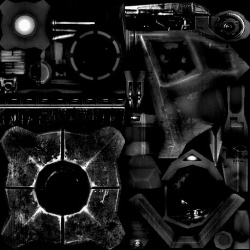$envmapmask/ru
$envmapmask - это параметр шейдера материала , доступный во всех играх на ![]() Source. Этот параметр определяет зеркальную маску [Specular mask], которая влияет на то, насколько сильно каждый пиксель материала отражает свет от
Source. Этот параметр определяет зеркальную маску [Specular mask], которая влияет на то, насколько сильно каждый пиксель материала отражает свет от$envmap. Маска должна быть изображением в градациях серого, в котором полностью отражающие области являются белыми, а полностью матовые области - черными. Для отражения диффузного типа, которое не зависит от$envmap,см.$phong.
$envmapmask не будет работать с материалами, использующими карты нормалей. Посмотрите #Альтернативные_методы.Пример синтаксиса VMT
$envmapmask <текстура>
VertexLitGeneric { $envmap env_cubemap $envmapmask "props/tvscreen_test" }
Дополнительные параметры

- Трансформирует маску зеркальной текстуры.
- Позиция по умолчанию:
center .5 .5 scale 1 1 rotate 0 translate 0 0.centerопределяет точку вращения. Приносит пользу только при использованииrotate.scaleвставляет текстуру в материал заданное количество раз.2 1— это 50%-ый масштаб по оси X.rotateвращает текстуру "против часовой стрелки/по часовой стрелке" в градусах. Принимает любое число, включая негативы.translateсдвигает текстуру до заданных значений. Значение.5сдвинет текстуру на 50%.
 Примечание:Все значения должны быть добавлены!
Примечание:Все значения должны быть добавлены! Ошибка:Масштабирование текстуры может вызвать странные проблемы, когда инструмент «Texture Lock» в Hammer фактически не фиксирует текстуру на месте.
Ошибка:Масштабирование текстуры может вызвать странные проблемы, когда инструмент «Texture Lock» в Hammer фактически не фиксирует текстуру на месте. Ошибка:Вращающиеся текстуры, примененные к брашам, будут вращаться вокруг начала координат карты. Чтобы исправить это, нужно изменить центральное положение в VMT на начало координат браша.
Ошибка:Вращающиеся текстуры, примененные к брашам, будут вращаться вокруг начала координат карты. Чтобы исправить это, нужно изменить центральное положение в VMT на начало координат браша.
$envmapmasktransform.CS:GO WorldVertexTransition Parameters
WorldVertexTransition.$envmapmask2.$envmapmask2.Альтернативные методы
Rather than creating a whole new texture for a specular mask, you can embed one into the alpha channel of the $basetexture or $bumpmap. Model materials with $bumpmap must do this. Unfortunately, it won't reduce memory usage.
If you do use these commands, transformations and other such parameters applied to $basetexture / $bumpmap will also apply to the specular mask.
$basetexture as the specular mask. $basetexture work in reverse. Transparent areas are reflective, opaque areas are matte. This is because, say, a window texture's alpha mask would be mostly black to allow for transparency -- yet that black part of the mask would also be the most reflective part. To avoid having to duplicate a texture file simply to invert the alpha mask, you can use this material parameter instead. Примечание:The alpha channel isn't inverted in the Source 2007 engine for models, but the alpha channel is inverted for brushes!
Примечание:The alpha channel isn't inverted in the Source 2007 engine for models, but the alpha channel is inverted for brushes!
 Ошибка:In CSGO, this parameter breaks materials using $translucent, limiting its usefulness. Use $envmapmask instead.
Ошибка:In CSGO, this parameter breaks materials using $translucent, limiting its usefulness. Use $envmapmask instead.
$bumpmap as the specular mask.
 Примечание:Will not work if
Примечание:Will not work if $basemapalphaphongmaskor$basemapluminancephongmaskare used.
$envmapmask as the $selfillum mask instead of $basetexture's alpha. In this event this command replaces $selfillum - do not use both.$tintmasktexture as the specular mask.Merging Specular Level into Normal Alpha in 3ds Max
To merge a Specular Level map into the Normal Map alpha, you can create a Composite Map node with the normal map in Layer 1 and the specular map in Mask 1. Then right-click the composite map, click Render Map and save this new image to file (remembering to keep the Gamma at 1.0 and using 32 bits per pixel in the save options).
These steps are automated in the Alpha Spec tool in Wall Worm 2.72+.
Также посмотрите
- $basetexture - основная текстура
- $envmap - карта окружения
- $phong - диффузное отражение
- $selfillum - самосвечение